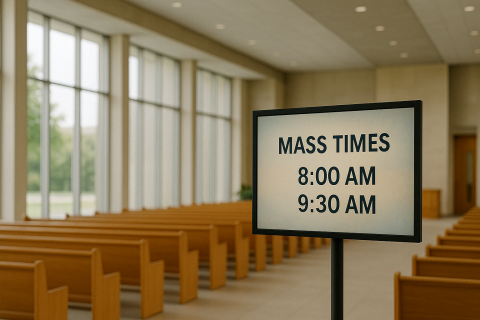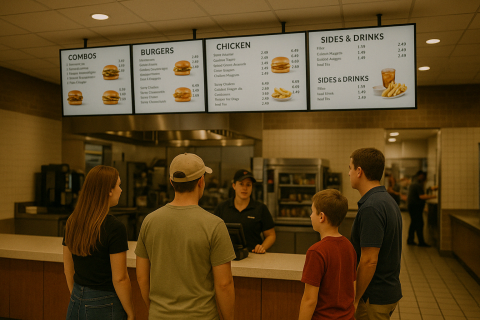In recent years, many churches and other religious organizations have started embracing technology to better engage their congregations and local communities. From live-streaming services to using social media for outreach, churches are finding new ways to connect and enhance the worship experience. One essential part of this digital transformation is the rise of electronic church signs – dynamic digital displays that are replacing traditional static church signs.
These digital church signs allow you to present messages in a visually engaging way, update content instantly, and communicate more effectively with church members. In fact, when used properly, digital signage for churches can greatly improve communication and even increase participation in services. For many first-time guests, the church sign makes a first impression even before they walk in. Digital signs can display a warm welcome message or inspirational quote that gives newcomers a taste of your church community. Instead of only sharing announcements during Sunday service or in a paper bulletin, a digital sign lets you reach people through multiple touchpoints – as they arrive in the foyer, walk the halls, or even drive by outside. It’s all about effective communication: delivering the right message at the right time in a way that captures attention and leaves a lasting impact.
In this article, we’ll cover ideas for launching digital signs for your church, and we’ll discuss how you can get started with Screenly.
Creative content ideas for church digital signs
What should you display on your digital church sign? Here are some popular content ideas that can help you engage your congregation and community:
Inspirational Bible verses & quotes – Share scripture or uplifting quotes that inspire and encourage your congregation. These daily messages can set a positive tone and keep people reflecting on faith throughout the week.
Service times & worship schedules – Clearly display your worship schedule, including Sunday service times, prayer meetings, Bible study nights, and any special services. This ensures everyone (including visitors) knows when and where worship events happen.
Announcements & upcoming events – Highlight upcoming church events, from Sunday school picnics to choir concerts to community outreach programs. Include event details like dates, times, and locations so members don’t miss out on church events or special events.
Community news & local events – If your church is involved in local happenings or supports community activities, use your sign to promote those. For example, an outdoor church sign can invite neighbors to a charity drive or let the local community know about a free concert on the church campus.
Welcome messages & member highlights – Make newcomers feel seen by programming warm welcome messages (e.g. “Welcome, we’re glad you’re here!”). You can also spotlight new members or volunteers (with permission) to build a sense of community and belonging among members.
Engaging extras – Keep content fresh by adding variety. Some churches include a “message of the day” from the pastor, birthdays or anniversaries in the congregation, or even fun touches like children’s artwork from Sunday school (a heart-warming personal touch). These little extras make your digital sign more attention-grabbing and relatable.
Each of these content types plays a role in building stronger ties within your church community. Whether it’s sharing a meaningful verse or highlighting a local event, your digital signs can help reinforce your church’s values and create a more welcoming and informed environment.
Best practices for church digital signage
To make the most of your church digital signs, keep these best practices in mind:
Pick the perfect placement - Position your signs for maximum impact. Place digital screens in high-traffic areas on your church campus – think entryways, lobbies, fellowship halls – where your congregation will see them often. For outdoor LED church signs, choose a spot visible from the road to catch the eye of passersby and potential members. Good placement ensures your message gets noticed by the people you want to reach.
Keep content fresh and relevant - Don’t let the same message sit on your sign for months. Update your digital sign content regularly to reflect current worship topics, upcoming events, or daily inspirations. This keeps people engaged and paying attention. Many digital signage tools (like Screenly) let you schedule content in advance, so you can plan a rotation of announcements, inspirational messages, and event reminders. Fresh content not only provides new information but also signals that your church is active and thriving, which draws more attention from members and visitors.
Mind local regulations Before you invest in that shiny new digital sign, be sure to check your local municipality’s rules on signage. Many areas require permits or a municipal code review for outdoor church signs, especially electronic LED displays. There may be regulations on the sign’s size, brightness, how frequently the message can change, or whether certain colors or animations are allowed. By doing your homework and complying with local codes, you’ll avoid fines and ensure your sign is a positive addition to the neighborhood (and not an unintended nuisance). If in doubt, consult city officials or even reach out to a sign company for guidance – many sign providers offer a free quote and are familiar with local sign ordinances, so they can help you navigate the approval process.
By curating meaningful content and keeping it updated, your digital signs can do more than inform—they can uplift, connect, and reflect the spirit of your church community.
What you need to build your church digital sign
Setting up an electronic sign may sound complex, but you actually only need a few key components to get started:
A screen or display - This is the surface where your content will show. It could be a TV, a computer monitor, or a dedicated LED sign. For indoor digital signs, a standard HDTV or commercial display works well (you might already have one on hand). For outdoor signage, you’ll likely use a weatherproof full-color LED church sign built for exterior use – make sure to invest in a quality LED sign that can withstand the elements. Whatever type of display you use, it should be large enough and sharp enough that text and images are easily readable by your audience. High resolution is important for a polished look, but you don’t necessarily need the latest 4K screen – just something with clear, bright output that’s appropriate for your viewing distance.
A digital signage player or browser-based screen - This is a small device (like a mini-computer or media box) that plugs into your screen and “drives” the content. Think of it like a DVD player, but for your slideshow, videos, and graphics. The player connects to the display (usually via HDMI) and runs your signage software. Screenly offers plug-and-play digital signage media players, but thanks to the new Screenly Anywhere feature, you can even turn hardware you already own into a player – any device capable of running a modern web browser can become your digital signage player. That means you could use a smart TV in the lobby or a spare PC in the office as part of your setup. The goal is simply to have a reliable player that can run all day and smoothly display your content.
Content management software - To control what appears on the sign, you’ll use digital signage software (a Content Management System for your signs). This software lets you upload images/videos, create playlists of content, and schedule what plays when. It’s the “remote control center” for your sign. As a church leader, you’ll want a user-friendly platform that doesn’t require specialized training. (If you can handle making a PowerPoint or Facebook post, you can handle updating a digital sign!) Screenly’s cloud-based signage software is one example – it allows you to easily manage your sign from a web browser on your laptop. With the right software, church staff can change messages in minutes via an online dashboard, rather than having to manually update the sign in person.
Internet connection - Finally, your digital sign setup will need internet access or a network connection. This allows you to send new content and updates to the signage player remotely. It can be via WiFi or a wired Ethernet connection, whichever is practical. A good internet connection means you can update your sign on the fly and even pull in live data if desired – for example, showing a weather update or social media feed as part of your display.
Once you’ve gathered the right tools, building your church’s digital signage system becomes a straightforward and rewarding process. A clear setup lays the foundation for meaningful engagement with your congregation.
Making digital signage easy (even for non-techies)
One of the biggest advantages of a platform like Screenly is that it makes digital signage incredibly easy to manage – even for volunteers or staff who aren’t tech experts. You don’t need an IT department or any special software training to run an electronic church sign. If you can drag-and-drop files or send an email, you can update a Screenly-powered sign!
Remote management - Screenly’s web-based dashboard lets you update your displays from anywhere. You can be in the church office or at home, and still change what’s showing on your church sign with a few clicks. Want to tweak the Sunday service announcement while you’re on vacation? No problem – just log in to the Screenly dashboard through any browser and update the content. This means you don’t have to physically go to the sign each time you want to change a message. Gone are the days of loading content onto a USB drive and plugging it into the sign for every little update. Everything updates over the cloud, which is a huge time-saver.
Use any hardware (Screenly Anywhere) - We mentioned Screenly Anywhere above, but it’s worth highlighting how it can help non-technical users. Screenly Anywhere allows you to deploy your signage on almost any device that has a web browser, with no additional hardware needed. That means you might not need to buy new equipment at all – for instance, you could use a smart TV in your lobby or a spare computer connected to a screen, and turn it into a digital sign just by running Screenly’s web player. This hardware-agnostic approach makes setup easier and can save money, since you’re leveraging devices you already have.
Easy scheduling and playlists - With Screenly, you can prepare content in advance and schedule it to display at specific times. For example, you might schedule a “Youth Group tonight at 7 PM” reminder to run only on Wednesday afternoons or set an inspirational quote to appear every morning at 8 AM. You can also create playlists that cycle through various slides (e.g., rotating between an announcements slide, a Bible verse, and an upcoming events preview). This ensures the right message shows at the right moment, automatically. You can plan out a whole week or month of content and let it run on its own – a big help for busy church staff.
Multiple screens, one control center - If your church has several digital signs – say one in the lobby, one by the sanctuary, and one in the fellowship hall – Screenly lets you manage all of them from the same interface. You can group screens together and update them all at once, or send specific content to specific screens (for instance, a special message just on the youth room sign). This centralized control saves a ton of time. Church staff could update a dozen screens across a church campus (or even across multiple campuses) in the same time it takes to update one, with just a few clicks. No more running around to each display to keep them in sync!
Edge Apps for dynamic content - Digital signage managers should also know about Edge Apps – a low-code way to add custom or dynamic content to your screens. This is an advanced feature, but it opens up exciting possibilities if you want to get creative. For example, you could use an Edge App to automatically fetch and display real-time information on your sign. Edge Apps run directly on the screen’s player hardware and can pull in data from other tools via Screenly’s API. In practical terms, that means your sign’s content can update itself from predefined sources – truly programmable LED signs that might show a different inspirational message every day without you manually changing it. While using Edge Apps is completely optional, it’s nice to know the capability is there as your digital signage strategy grows. Even without any coding, Screenly provides some built-in integrations (apps) to simplify tasks like displaying calendars, news, or weather.
Overall, the goal is that managing your digital church signs should not add stress to your day. Modern digital signage platforms like Screenly are designed so that anyone on your team can learn the basics quickly. The interface is intuitive and user-friendly, so you can focus on the content of your message rather than wrestling with technology. If you ever need help, Screenly provides support resources to guide you. In short, digital signage tools make it easy to engage your congregation and community – no tech genius required.
Ready to get started? Try Screenly free for 30 days
Digital signage can be a game-changer for church communication. Try Screenly’s free 30-day trial to see how easy it is to share timely, engaging content that informs and inspires your congregation.





